I came across a short interview with Phil Oakey at Synth Fest 2019 where he talked about hardware sequencers that allow you to multiply steps. I had to learn more.
The Sonic State interview by Gaz Williams was short and impromptu, but I pieced together what he said and started exploring this style of sequencer. It looks like he was referring to the RYK M185 and the Intellijel Metropolis. Both of these sequencers let you adjust how many times each note in the sequence will repeat, hold, or skip. Long and varied sequences can be developed and shaped in real-time with interactive controls for stage count, gate mode and more. Engaging rhythms can emerge using a few easy to grasp controls. There is a lot to explore here.
I got in touch with Jake from RYK and Danjel from Intellijel to get more insight into these designs.
RYK
Jake is the founder of RYK based in London. I talked with him about how he developed the idea for this innovative type of sequencer.
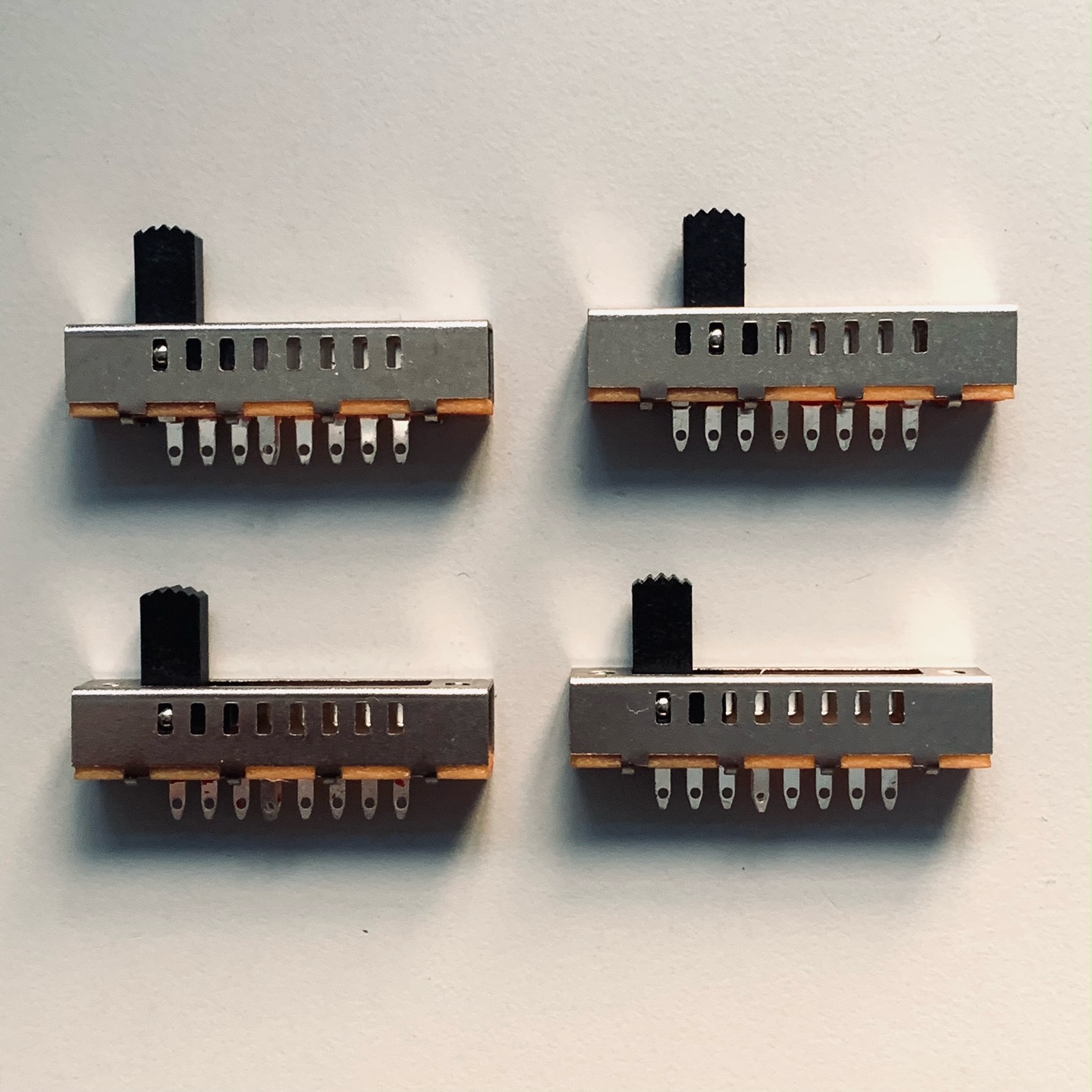 The Famous 8 Way Switches
The Famous 8 Way Switches
The RYK M185 sequencer was where this idea first appeared. It began when Jake discovered 8-way slide switches that sparked his imagination while visiting an electronics market in Beijing. Up to that point, the largest slide switches he had seen were 4-way switches. A switch with 8 positions could be applied in a musical context. He bought a bag of the switches, took them home and started experimenting. At the same time he saw a video of the Japanese band Yellow Magic Orchestra using a Moog sequencer that had the ability to skip notes. This technique allowed for interesting rhythms rather than continuously repeating notes on every beat. With an interest in rhythm from playing drums, Jake started to think about how the switches he discovered could be used to change the rhythm. This was the inspiration for the M185 sequencer concept.
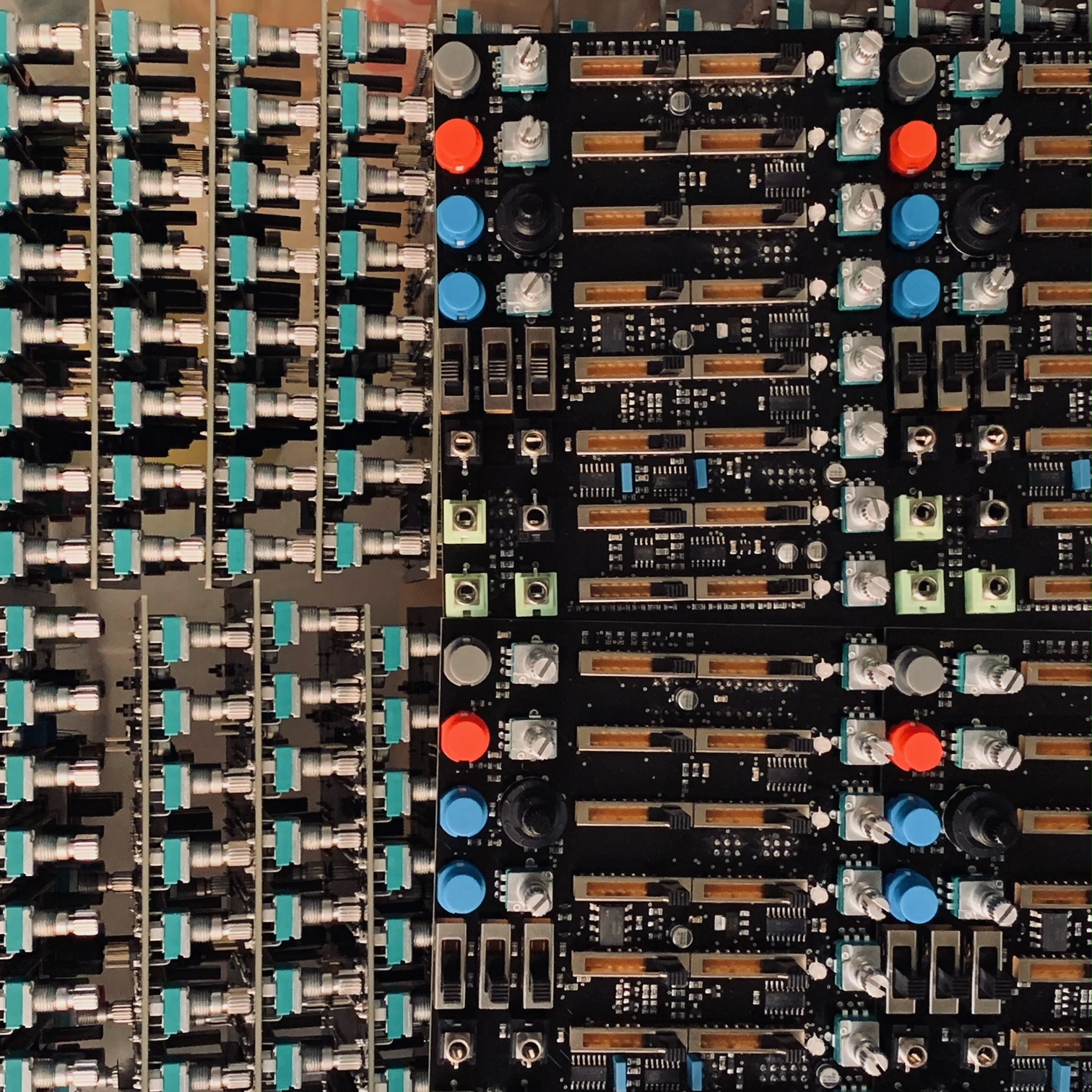 M185 Eurorack Modules Before Panel Installation
M185 Eurorack Modules Before Panel Installation
The first version of the design was built with discrete logic and counter chips, but that turned out to be complicated. Jake then turned to microcontrollers and programmed the functionality using a PIC chip. This led to the 2009 release of the M185 in a form factor that plugs in to the Roland System 100M modular synth.
“Jake has a keen eye for industrial design and he took a hands on approach to custom molding and tooling for the M185” -Danjel of Intellijel.
The Roland System100M is an iconic modular synth first released in 1979 and produced for about five years. The RYK M185 is designed to look right at home in a System 100M. The fonts, front panel texture and custom knobs were meticulously designed to match the aesthetics of the 100M modules.
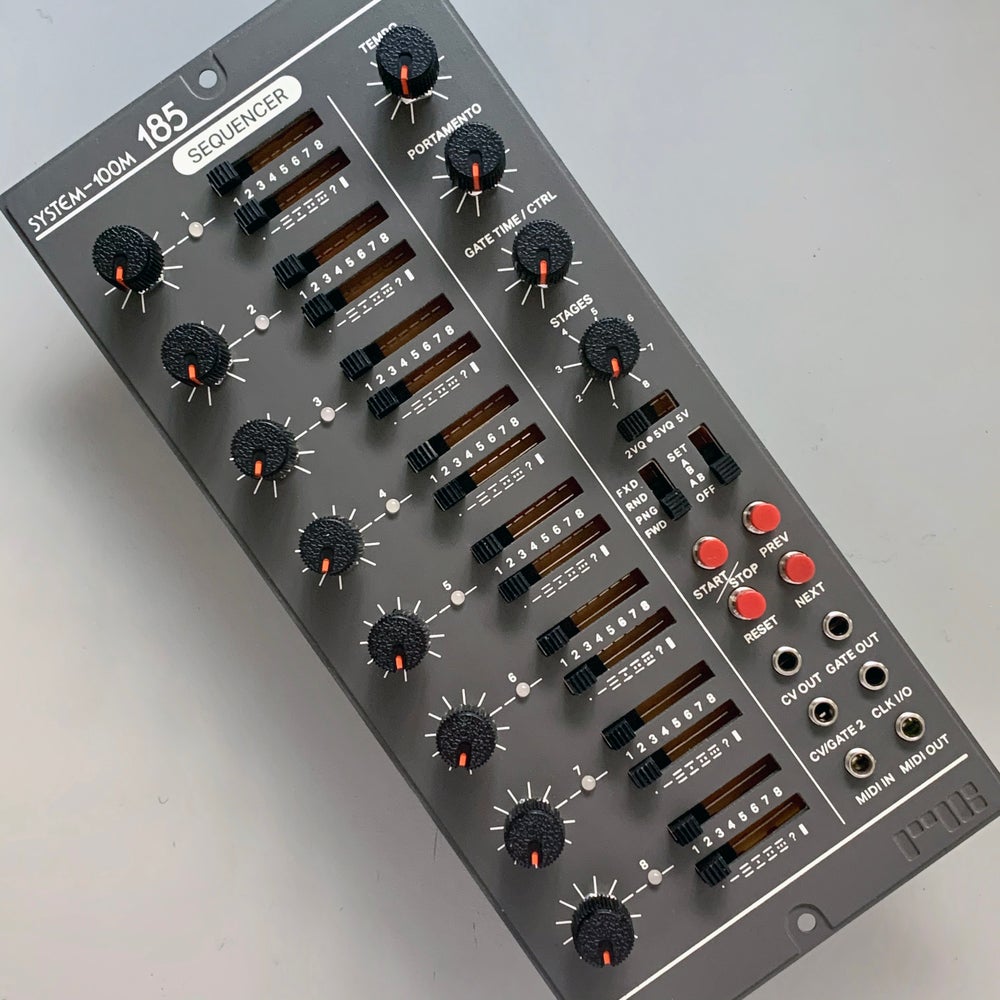 The RYK M185 Roland System 100m format
The RYK M185 Roland System 100m format
The model number M185 was chosen to continue the Roland numbering scheme. M18x designates a controller and the last in the Roland 100m series was the M184 keyboard.
RYK released a DIY kit for the M185, and there is an entertaining video by Molten Modular documenting the build process.
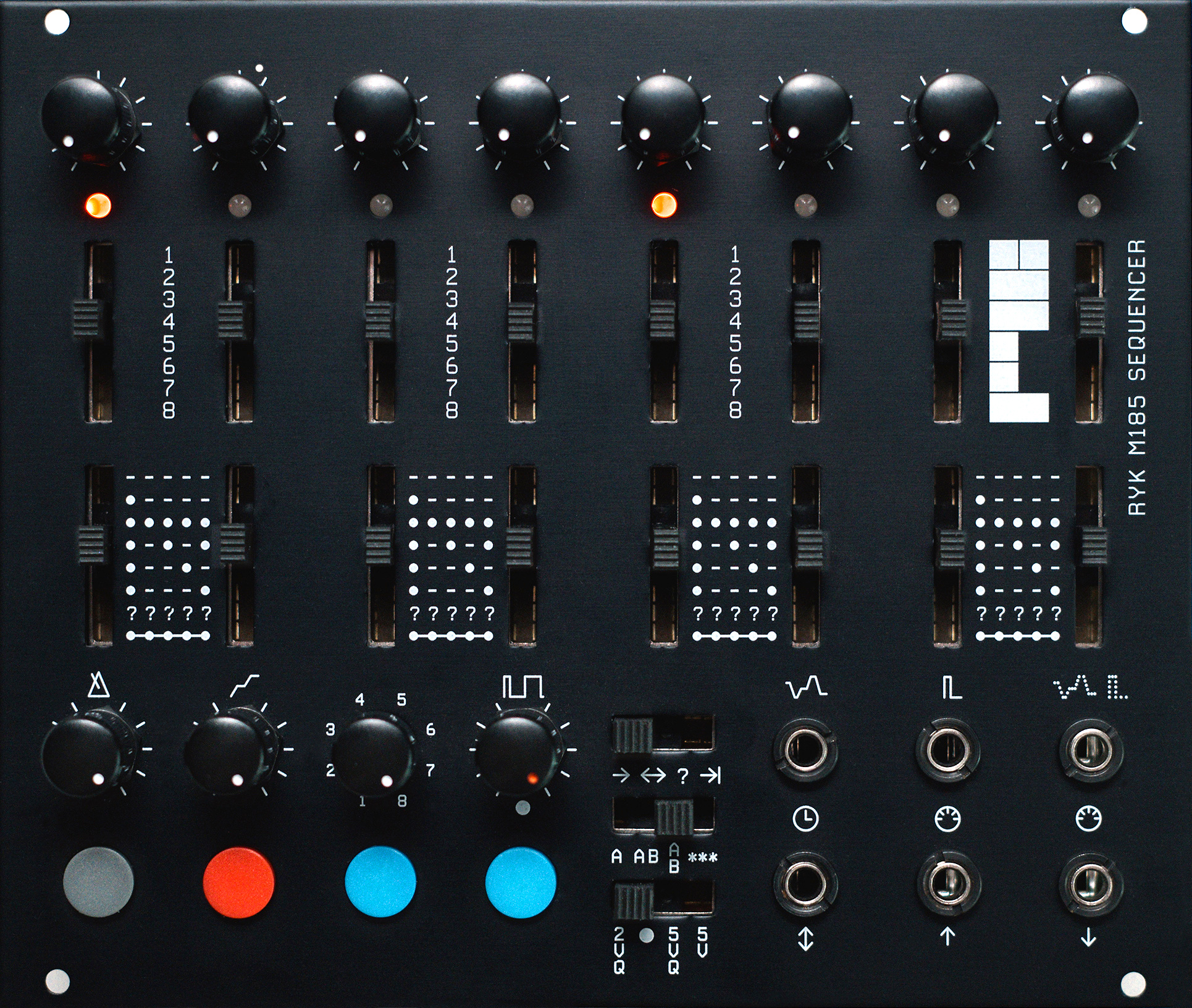 The M185 Eurorack Module
The M185 Eurorack Module
The Eurorack version we released in 2020 was significantly updated from the 2009 version, to include new gate modes, quantization, and parallel split functions.
The split serial and parallel modes are powerful. How did that idea come about?
I play drums and am really into rhythm, I think that’s where the idea came about. Traditional Sequencers play linear notes one after the other and I thought this would be a lot more interesting. In this mode a sequence can be split into two parts “A” and “B” with each part playing a designated number of times, in serial or parallel.
In split mode, the reset feature allows a gate from sequence “B” to reset sequence “A” which can create really weird polyrhythms. I think that’s nice.
The “B” sequence can offset the notes of the “A” sequence for key changes, similar to the song “I Feel Love” by Donna Summer.
Are there any features that might not be obvious at first?
When setting up a sequence, you can preview and tune the notes by manually stepping forward and backwards through the pattern. It is an interesting way to find a melody similar to how you would do that on a piano. Then you can experiment with the rhythm using the switches.
Fixed mode is useful for dance music genres. You can lock the sequence to a preset length of time rather than altering the length each time you change the stage count.
The M185 has a mode where the incoming clock is doubled to support 16 PPQN sync with the OP-1 or the Korg Volca series. The OP-1 can send a sync pulse on one channel of the audio output and that can be used to clock the M185.
Intellijel
I spoke with Danjel, the founder of Intellijel in Vancouver, about the Metropolis and the recently released Metropolix.
Inspired by the concept of the M185, Danjel licensed the design from RYK and created the Metropolis with many added features. This Performance oriented, gate multiplying sequencer is a hit with the modular community. In 2021 the Metropolix was introduced with more features that build upon the Metropolis model.
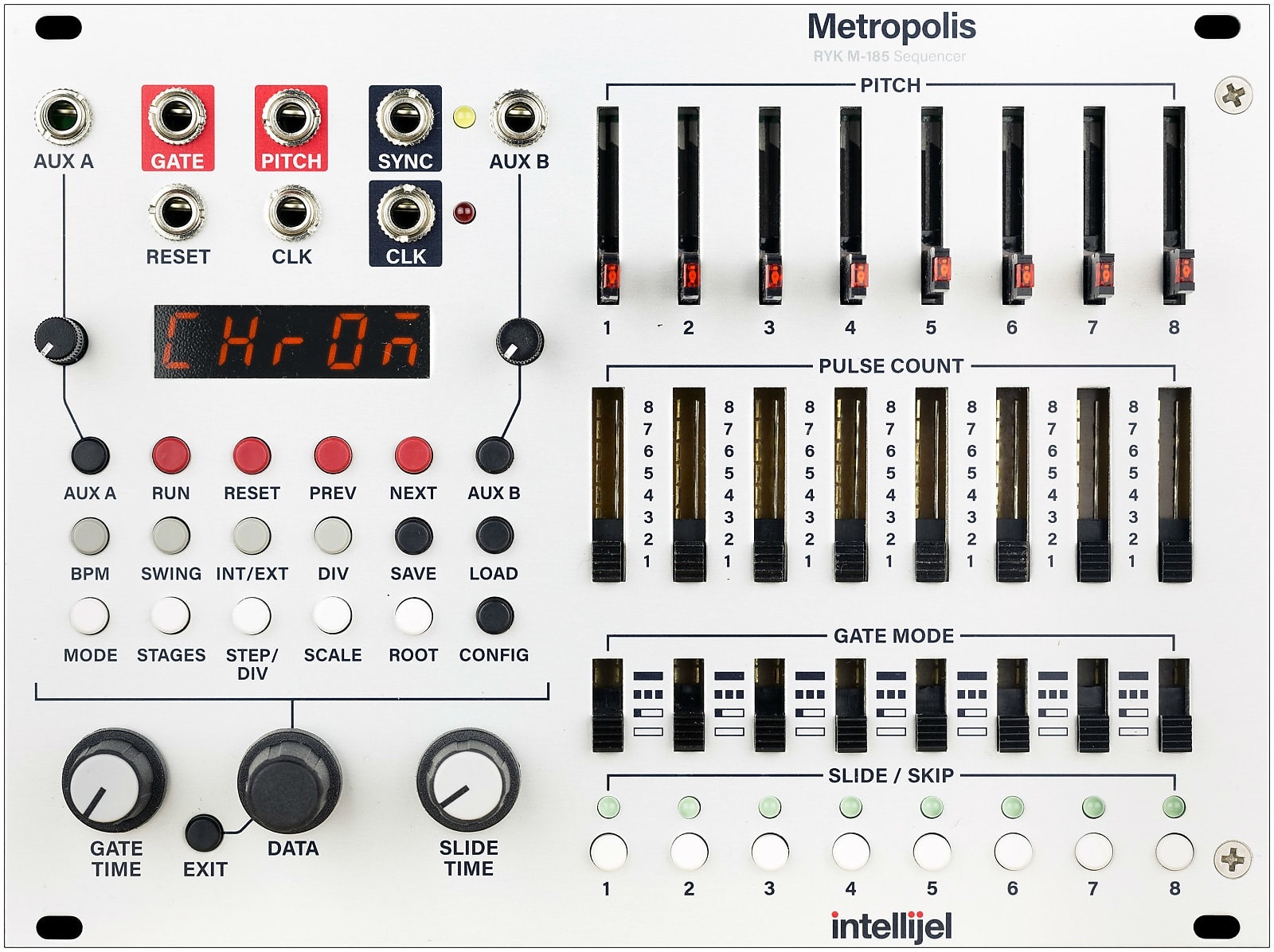 The Intellijel Metropolis
The Intellijel Metropolis
What motivated you to build on the RYK concept?
I was in tune with what things were missing or felt sterile to use in existing sequencers from my own experience making techno music.
You can get complex patterns that do not appear to repeat in a short phrase, but you have decided how you want it to move.
The Fundamental concept of making a relationship between gate modes and pulse counts was really unique. It was hard to escape building something around that idea, even though we had a lot of other ideas to expand on or build around. I eventually persuaded Jake to license his design.
There is a culture in music tech industry of people cloning and copying things without thinking about how much work has gone into creating a design. Without appreciating the work involved, a design can be dismissed as quick idea someone cranked out. It was important for us to get Jake’s permission and license his idea which turned into the Metropolis.
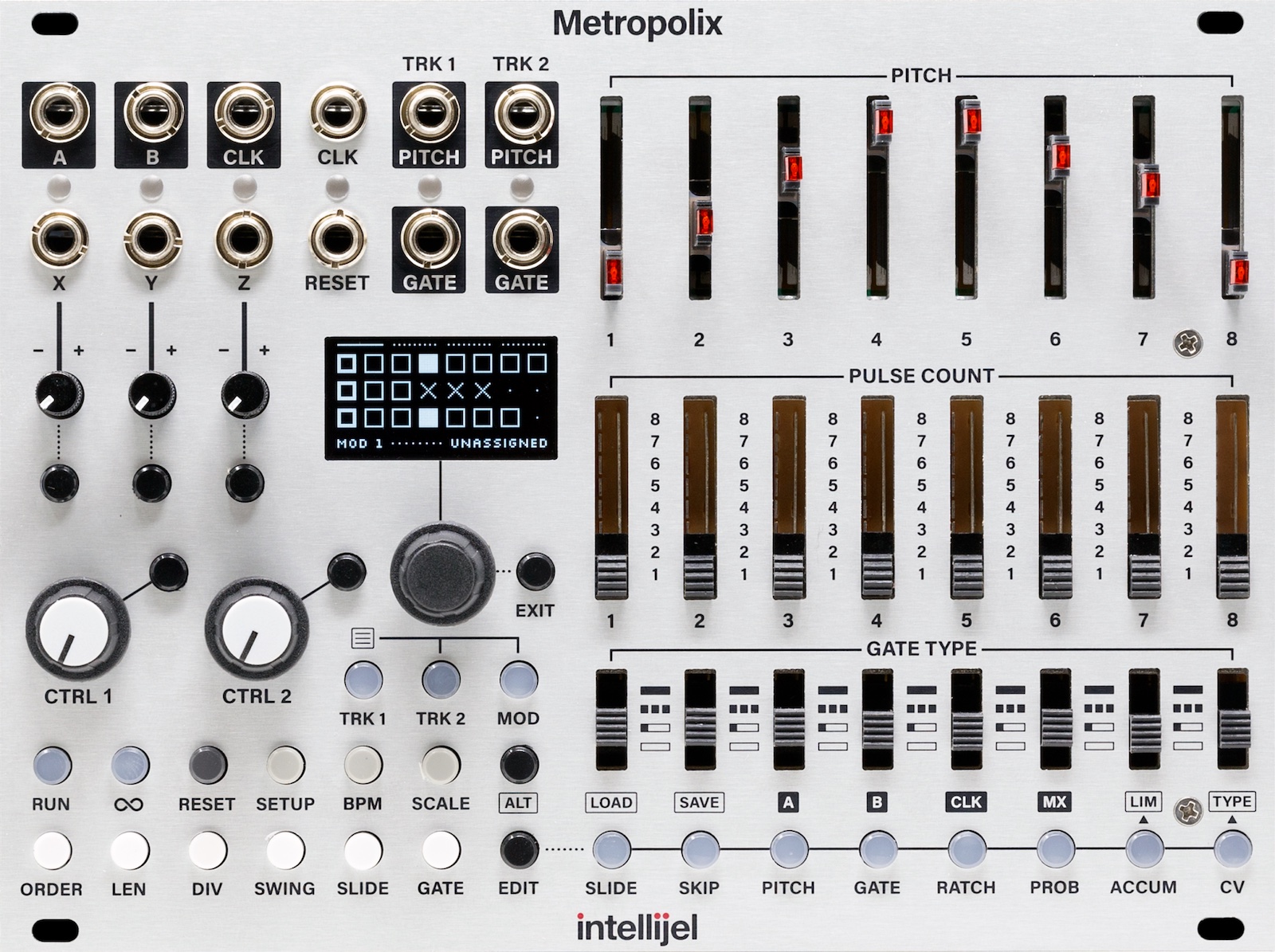 The Metropolix - The next Iteration of the Metropolis
The Metropolix - The next Iteration of the Metropolis
How do the Metropolis and Metropolix differ from a traditional sequencer?
Traditional sequencers are good for creating intentional melodies with a repeating rhythm, either by entering notes, or using a simple set of knobs to set pitches. This has a purpose and pairs well with other parts in a tune.
You will almost always stumble across a catchy riff. For most musicians we hope that gives it a lot of value.
The Metropolis and Metropolix are known as riff machines. You are less likely to do something very purposeful, but you can generally direct the rhythm and feel you want. You will almost always stumble across a catchy riff. For most musicians we hope that gives it a lot of value. It can be a catalyst for the backbone of an entire track like a lead riff or bass line. Once you get a fundamental riff going, you can make minor changes to create variations and interact with it to expand on the idea. You can surprise yourself.
The variations are not random or based on probability, you are setting the conditions and your understanding of how it was setup will allow you to manipulate the sequence once it is flowing. Metropolix builds on this particular aspect with more controls over what the sequencer can do.
Complex but not random, is this one of the strengths of this approach?
Though there are randomization features, it is the algorithmic influence that is a powerful tool.
This is more than an eight step sequencer. With the sliders, direction modes, probability and other features you quickly go beyond 8 steps. Yet it is not random, you can build patterns that repeat over a long period with structure and rhythm that will hold together as a track.
Once you understand how the sliders, modes and other features work, you can get complex patterns that do not appear to repeat in a short phrase, but you have decided how you want it to move. It makes me want to interact with it in real time. The result is likely to sound different from what you create using software tools in a DAW.
How do you like to use this style of sequencer?
I find a voice I want to work with, start with a simple pattern and see how I can mutate it from there to create something more organic.
Modulating a sequence in real-time is one of my favorite techniques with the Metropolis. Once a riff is going, I use a four bar sequence from another module to transpose the sequencer. Boards of Canada style chord changes can be achieved using this technique. This can break out from one bar loops to something with more melodic phrasing.
The Metropolis concept has been popular for old school acid techno, but I have had as much fun slowing down the tempo, adding reverb and creating ambient tracks. The changes can’t be abrupt, but you do want change to happen, the Metropolis is great for that style.
The random modes tend towards musical results. Can you talk about these modes?
The Metropolix has several random modes that were influenced by the Buchla school of thought. The random modes are not purely random, but have some intention. In Drunken Walk or Brownian mode, you have a 50% chance of moving forward, a 25% chance of going backwards, and a 25% of staying on the same step. It is trending forward, instead of purely random. That small mathematical tweak gives it a different feel, that is more musical and organic than a purely random approach. You get a sense of moving in a direction, but it is a more elaborate path to get there. You are pairing randomness with the framework of a quantized rhythm and a quantized scale, which keeps it musical.
 Accumulator Diagrams From the Manual
Accumulator Diagrams From the Manual
Do you have a favorite feature?
One of my favorite features in the new Metropolix is the accumulator.
Years ago, I wrote a Max/MSP sequencer with an accumulator loosely influenced by the Latronic Notron, a rare hardware sequencer. The Notron is popular with well-known musicians and influential in the design of the Sequentix Cirkon sequencer. I knew from experience how fun the accumulator concept was to use and the fresh sounds it could enable.
The accumulator can be applied at the pulse, stage or track level, and each time the sequence cycles through that point it adds or subtracts an interval. Once the note value reaches a max or min, you have several options, stop changing, loop back to the starting point, ping-pong, and more. When combined with ratcheting, you can get arpeggiated trills. The accumulator can be applied to the whole track for arpeggios or chord progressions. Once you incorporate all the other modes the sequence will quickly mutate.
Conclusion
There is a great review of Metropolix by loopop covering all of the features, see link at the end of the article. Since that review there have been three major updates; pattern chaining, accumulator enhancements, and customizable scales.
Thanks to Jake and Danjel for taking time to talk about their designs. They both have a passion for what they are doing and it shows in their products. If you are looking for a sequencer that will inspire new rhythms and melodies, take a look at all of these sequencers.
More to Explore
Metropolix Accumulator Overview
Mylar Melodies video for the Metropolix
DIY Build of the M185 by Molten Modular
Intellijel Metropolix Review and Full Tutorial by Loopop
If you have suggestions or topics you want covered please contact me. 🙂

